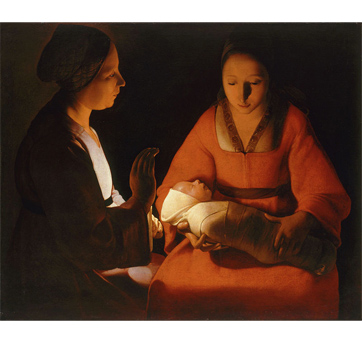For the feast-day of St. Anne, the blessed Virgin’s mother, we will be looking at the painting “The Newborn Child” (ca. 1648) by Georges de La Tour (1593-1652), hanging in the “Musée des Beaux-arts” in Rennes which is worth a detour.
At first sight, this painting seems to represent a simple, domestic genre scene, as one liked them at the time from the paintings of Louis Le Nain. But a closer look shows us that it is a nativity scene, itself in the tradition of the trinitarian images of St. Anne, the grandmother of Jesus.
A Trinitarian Sainte Anne or a Marian Trinity
Though saint Anne is not mentioned in the Gospels, her name as the spouse of Joachim appears in the apocryphal writings from the 2nd century onwards. However, the devotion to St. Anne was only officially introduced in 1481 by pope Sixtus IV, the pope who also spoke in favor of the Immaculate Conception. Yet it became widespread during the Middle Ages, and after some decline, regained popularity in the 17th century. It is Pope Gregory XIII who set its feast-date for all Christendom on July 26th.
St. Anne was often depicted in terms of her maternity: be it as the teacher of the blessed Virgin, or under a “trinitarian” form, assembling three generations. The group of Saint Anne (the grandmother), the Virgin (the mother) and the child (Jesus) emphasize the maternal genealogy of Jesus. The trinitarian form of the three generations, which became an iconographic theme from the 13th century onward, has a theological foundation: a kind of “predestination” of Anne in God’s mind to give birth to the Immaculate Conception. Hence the maternal, corporal and earthly trinity echoes the theological, paternal and spiritual Trinity. However, the Church eventually forbid this depiction so that it would not be confused with the holy Trinity.
«The New Born Child » by Georges de La Tour (ca. 1648)
Though Georges de La Tour’s painting reflects this trinitarian iconographic tradition, it still introduces something new; generally, one sees St. Anne as if she herself were the throne for the blessed Virgin whom she holds on her lap and who in turn carries baby Jesus. Yet here the grandmother is shown from the side: she blesses the birth of the world’s Savior who is carried and presented delicately by the Virgin Mary, contemplating Him reverently. One’s gaze is turned towards Him who is shown by candle-light, hidden by the grandmother’s gesture combining both blessing and protection. The candlelight’s play of light and shadow creates an atmosphere of intimacy that speaks to the soul, allowing it to recollect itself, while revealing a mystery.
Georges de La Tour appropriates for himself the tradition of the chiaro-oscuro, initiated by Caravaggio who also inspired him to put religious themes in an everyday setting with a sober décor and as simple genre scenes.
The Infant Jesus
The tightly swathed child with several bonnets on His head, as was the fashion, already prefigures Jesus’ death, for He is tied up like a mummy. One frequently relates the mystery of the nativity to that of Christ’s passion, and the artist here weaves into his painting a series of symbols, inviting us to contemplate the divine mysteries.
In this representation, everything is stylized, yet becomes a sign without forcing its revelation upon us. St. Anne who lifts her hand in a gesture of blessing and protection hides thereby the source of the light, namely the candle. This light therefore shines upon Him who is the true light of the world, who is the incarnation, in the strong sense of the term, of this light.
A Prophetic Epiphany
The fact that the painting does not contain any narrative element (no decor, a setting without any specific reference to time or place) leads one to another reality which is not subject to time: an opening towards eternity, an epiphany of the infant Jesus, “the” newly born among all, Himself birthing a new world. This epiphany is prophetic by its discrete announcing of the newborn’s death whose eyes are already closed and whose mother contemplates Him so gravely, as if she were already accepting His future destiny.
Let us ask the Virgin Mary and St. Anne to protect our family bonds. Mary, Undoer of knots, we ask you together with your mother, St. Anne, to untie the knots of those hurt by inter-generational wounds: the relationships between parents and children as well as between grand-children and grand-parents, so that the sometimes fragile bonds within the family be preserved.
Isabelle Rolland
For more information:
On sainte Anne
Iconographic source : https://fr.wikipedia.org/wiki/Georges_de_La_Tour#/media/Fichier:Georges_de_La_Tour_-_Newlyborn_infant_-_Mus%C3%A9e_des_Beaux-Arts_de_Rennes.jpg

